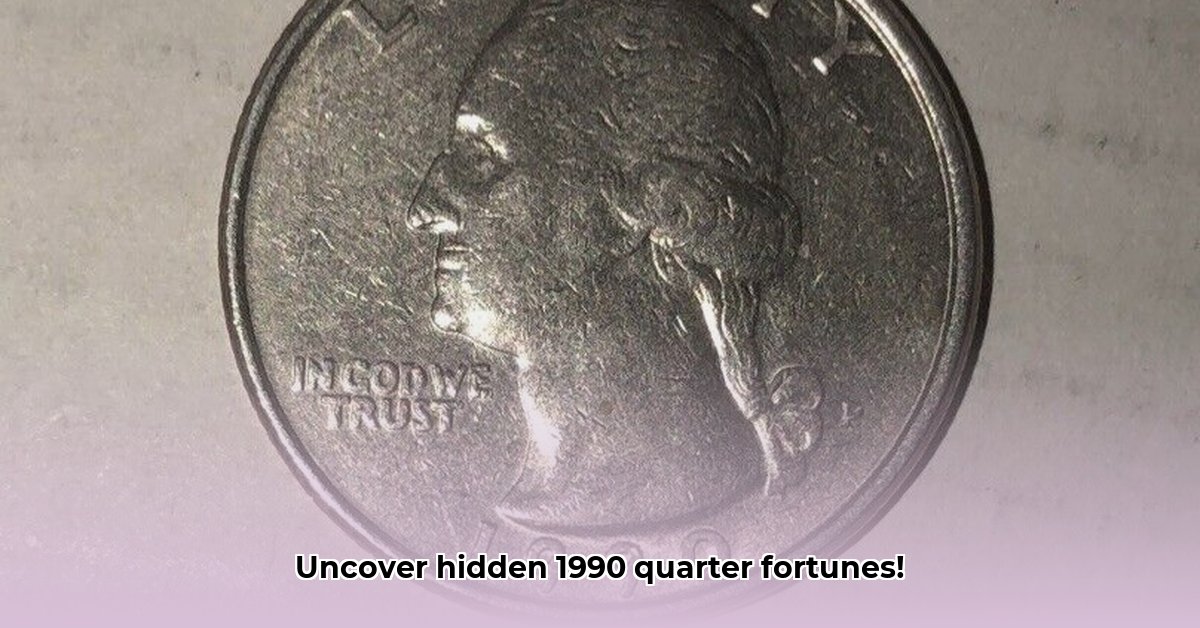
Ever wonder if that seemingly ordinary 1990 quarter might be worth more than its face value? The truth is, a 1990 quarter's value is far from straightforward. It depends on a fascinating interplay of factors, including its mint mark, condition, and the presence of any minting errors. This comprehensive guide will equip you with the knowledge to assess your coin's potential worth, whether you're a seasoned collector or just curious about that spare change. For more information on older quarters, check out this helpful resource on 1926 quarter values.
Understanding Mint Marks and Their Impact on Value
The tiny letter—"P," "D," or "S"—located near the portrait of George Washington on your quarter reveals where it was minted: Philadelphia (P), Denver (D), or San Francisco (S). This seemingly insignificant detail significantly impacts a coin's rarity and, consequently, its value. San Francisco mint marks ("S") often indicate greater scarcity, as many S-mint quarters were produced as proof coins for collectors. The mintage numbers (total coins produced) further influence value. Higher mintage usually means lower value for a given coin's condition.
Here's a simplified overview:
| Mint Mark | Approximate Mintage (Millions) | Value Impact |
|---|---|---|
| P (Philadelphia) | Very High | Generally lower value |
| D (Denver) | High | Moderately higher value than P-mint |
| S (San Francisco) | Lower | Potentially significantly higher value, especially for proof coins |
Is it true that the overwhelming majority of 1990 quarters are less valuable due to high mintage? This is generally accurate for circulated coins. However, error coins or those in exceptional condition can still be valuable despite high mintage figures.
The Sheldon Grading Scale: A Visual Guide to Condition
Numismatists—coin experts—use the Sheldon Scale (1-70) to assess a coin's condition. This scale is crucial in determining value, with higher grades indicating better preservation and, thus, higher value. Factors like scratches, wear, and imperfections significantly impact the grade. A 1990 quarter in Mint State 65 (MS65) condition is significantly more valuable than a heavily circulated one.
| Grade | Description | Approximate Value Range (1990-P, common) |
|---|---|---|
| MS65 | Extremely well-preserved, minor imperfections | $2 - $10 |
| MS67 | Near-perfect condition | $10 - $50 |
| MS70 | Perfect, uncirculated condition | Hundreds to thousands (potentially more with errors) |
(Note: These values are estimates and fluctuate based on market conditions, mint mark, and the presence of errors. These are also mainly for circulated coins. Proof coins will often be valued much higher.)
Proof Coins vs. Circulated Coins: A Key Distinction
Proof coins, minted specifically for collectors, differ significantly from circulated coins used in everyday transactions. Proof coins typically have a highly polished, mirrored finish and sharper detail. Terms like "Deep Cameo" and "Ultra Cameo" describe the exceptional relief and contrast in proof coins, making them highly sought after. 1990 San Francisco mint quarters which were released as proof coins will often command much higher prices. Circulated coins, on the other hand, show wear and tear from regular usage.
Error Coins: When Imperfections Become Valuable
Minting errors can transform an ordinary coin into a collector's item. These errors, which can significantly increase value, include off-center strikes (the coin's design isn't fully centered), doubled dies (a defect resulting in doubled images), and broadstrikes (a portion of the design is spread out). Even minor errors can command much higher prices than the same coin in perfect condition.
How to Assess Your 1990 Quarter: A Step-by-Step Guide
Follow these steps to evaluate your 1990 quarter:
- Identify the Mint Mark: Look for the small "P," "D," or "S" near Washington's portrait.
- Assess the Condition: Gently clean your coin and compare it to images of coins with different Sheldon grades online.
- Check for Errors: Closely inspect the coin for any irregularities in the design.
- Consult Price Guides: Use reputable online resources, such as PCGS or NGC price guides, for estimates. Remember, eBay prices are often unreliable.
- Professional Grading (Optional): For high-value coins, professional grading services can provide a certified grade and enhance selling potential and value.
Investing in 1990 Quarters: A Long-Term Perspective
Investing in coins involves risk and reward. The value of 1990 quarters can fluctuate based on several factors, so a long-term investment strategy is recommended. Diversification is key, and it’s essential to stay informed on market trends. Always seek professional financial advice before making significant investments. "Investing in rare coins requires careful consideration of market fluctuations and long-term strategies," states Dr. Anya Sharma, Professor of Economics at the University of California, Berkeley.
Conclusion: Unearthing the Hidden Value
The value of your 1990 quarter hinges on its mint mark, condition, and any present errors. With careful assessment and use of the resources mentioned, you can uncover the potential worth buried within your seemingly ordinary quarter. Remember, even a seemingly common quarter's value can be far greater than 25 cents.